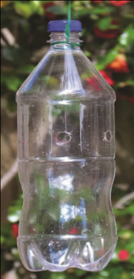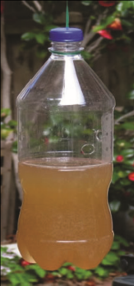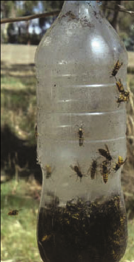Wasp Trapping with The Laurie Lure
|
THE TRAP 1.25L PET bottle Cut three holes of 1cm diameter about 15cm up from the base of the bottle. Leave the screw-top cap on the bottle. THE LAURIE LURE Dissolve 130ml of honey into 600ml of hot water. Add 6ml of pure vanilla essence containing 35% alcohol. Let the mixture ferment for at least 1 week before you distribute to the traps so bees will not be attracted to it. Divide the lure between 5 traps (approximately 140ml per trap). Top up with water to just below the holes. Replace the screw-top cap. THE OPERATION Use twine or wire to hang the trap in sunny areas near water, 2m above ground. Monitor traps regularly and shake lure every few days. Remove trapped wasps using a mesh kitchen strainer and bowl. Re-use bait and top up with water. Replace Laurie Lure every 4-5 weeks. |
Download the PDF
| wasp_trapping_laurie_nicolls.pdf | |
| File Size: | 131 kb |
| File Type: | |
Laurie Nicoll developed this lure and presented it via Gardening Australia in late September 2015. His intention was to capture and destroy the wasp queens before they established new colonies. This method has been used successfully to stop the creation of many new wasp hives.




